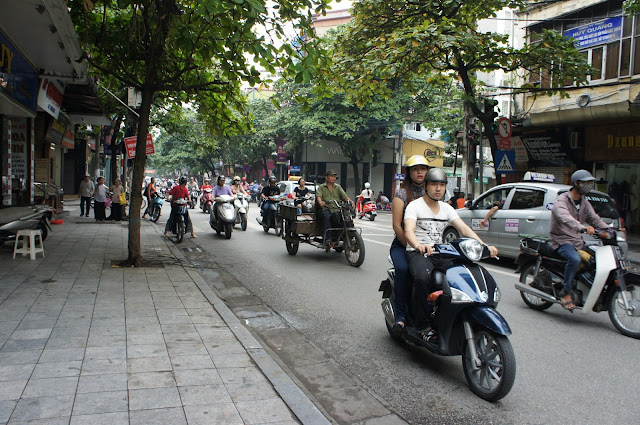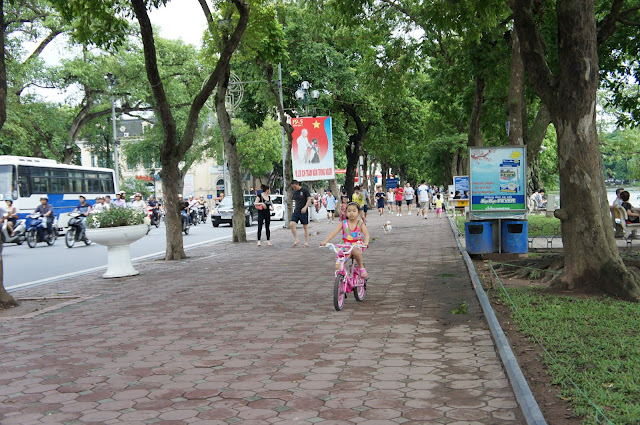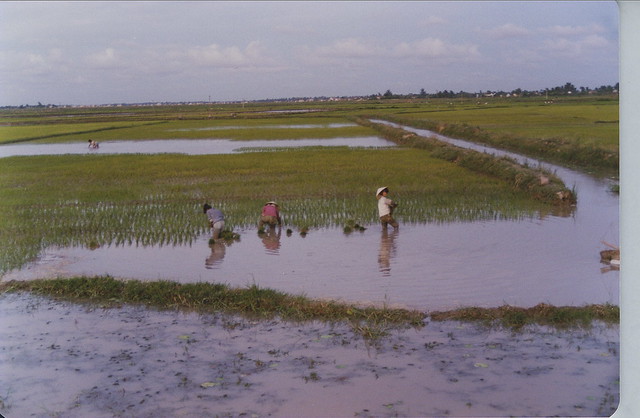Day 5
Today is our last day in Hanoi. And the final place we like to visit is Hoa Lo Prison.
Woke up about 7.30 am, packed up and had our breakfast at 8 am.
As usual, I enjoyed the beef pho and fresh fruits and a cuppa of Vietnamese coffee.
Then we took an easy stroll to the Hoa Lo Prison, aka Hanoi Hilton by the Americans. It is about 15 minutes from the hotel. If you are further away, the easiest way to get to Hoa Lo Prison is by taxi - 1 Pho Hoa Lo is right at the corner of Pho Ha Ba Trung, south of Hoan Kiem Lake on the lip of the French Quarter.
View Larger Map
The Prison is open from 8am to 5pm, every day of the week, with a lunch break from 11:30am to 1:30pm. An entrance fee of VND 20,000 (about USD1) is charged at the gate.
Hoa Lo Prison was originally built by French colonialists in the nineteenth century. Used to incarcerate Vietnamese political prisoners, it was known by the French as Maison Centrale - literally, Central House, a traditional euphemism to denote prisons in France. It was located near Hanoi's French Quarter. The prison was built in Hanoi by the French, in dates ranging from 1886–1889 to 1898 to 1901, when Vietnam was still part of French Indochina.
In 1964, the Vietnamese began using Hoa Lo Prison as a prisoner of war camp for US troops during the Vietnam War. It was at this time that the prison gained its ironic nickname of the “Hanoi Hilton”. The most famous prisoner at Hoa Lo Prison was Senator John McCain, who was imprisoned there for five and a half years.
Throughout its existence, Hoa Lo Prison has been a place where inmates have been subjected to dire conditions and torture, both under the French and the Vietnamese.
Whilst most of Hoa Lo Prison has been demolished, its remaining sections form a museum where visitors can enter through its red archway, known as the “monster’s mouth” to tour the site.
Most of the exhibits relate to its time under French rule, but a tour of Hoa Lo Prison also offers some insight into the horrors experienced by American POW’s.
A stay in the Hanoi Hilton was no picnic. From day one, Hoa Lo was horrifically overcrowded - while its maximum capacity was 600 prisoners, over 2,000 were confined within its walls by 1954.
Prisoners in Hoa Lo were shackled to the floor, and were often beaten by the guards. The "E" stockade housed political prisoners, who were cuffed in a seating position and arranged in two rows. A latrine stands at one end of the stockade, in full view of other prisoners.
Executions were carried out in Hoa Lo Prison by way of a mobile guillotine, which still stands near the prison's death row.
In today's Hoa Lo Prison, the American POW experience in Hoa Lo prison is presented - whitewashed, actually - in two displays made up to look like comfortable barracks. Back in the day, though, this area was the dreaded "blue room", where new prisoners were interrogated and tortured if they didn't comply. Former POW Julius Jayroe tells of his first experience in the Blue Room:
Airfare (2pax) from Singapore (Tiger Airways) S$ 652
Hotel for 4 nights S$156
Food & Meals S$130
Taxis S$47
Shopping $138
Local Tours S$56
Others S$25
TOTAL : S$1200 ( USD 1000)
Today is our last day in Hanoi. And the final place we like to visit is Hoa Lo Prison.
Woke up about 7.30 am, packed up and had our breakfast at 8 am.
As usual, I enjoyed the beef pho and fresh fruits and a cuppa of Vietnamese coffee.
Then we took an easy stroll to the Hoa Lo Prison, aka Hanoi Hilton by the Americans. It is about 15 minutes from the hotel. If you are further away, the easiest way to get to Hoa Lo Prison is by taxi - 1 Pho Hoa Lo is right at the corner of Pho Ha Ba Trung, south of Hoan Kiem Lake on the lip of the French Quarter.
View Larger Map
The Prison is open from 8am to 5pm, every day of the week, with a lunch break from 11:30am to 1:30pm. An entrance fee of VND 20,000 (about USD1) is charged at the gate.
Hoa Lo Prison was originally built by French colonialists in the nineteenth century. Used to incarcerate Vietnamese political prisoners, it was known by the French as Maison Centrale - literally, Central House, a traditional euphemism to denote prisons in France. It was located near Hanoi's French Quarter. The prison was built in Hanoi by the French, in dates ranging from 1886–1889 to 1898 to 1901, when Vietnam was still part of French Indochina.
In 1964, the Vietnamese began using Hoa Lo Prison as a prisoner of war camp for US troops during the Vietnam War. It was at this time that the prison gained its ironic nickname of the “Hanoi Hilton”. The most famous prisoner at Hoa Lo Prison was Senator John McCain, who was imprisoned there for five and a half years.
Throughout its existence, Hoa Lo Prison has been a place where inmates have been subjected to dire conditions and torture, both under the French and the Vietnamese.
Whilst most of Hoa Lo Prison has been demolished, its remaining sections form a museum where visitors can enter through its red archway, known as the “monster’s mouth” to tour the site.
Most of the exhibits relate to its time under French rule, but a tour of Hoa Lo Prison also offers some insight into the horrors experienced by American POW’s.
A stay in the Hanoi Hilton was no picnic. From day one, Hoa Lo was horrifically overcrowded - while its maximum capacity was 600 prisoners, over 2,000 were confined within its walls by 1954.
Prisoners in Hoa Lo were shackled to the floor, and were often beaten by the guards. The "E" stockade housed political prisoners, who were cuffed in a seating position and arranged in two rows. A latrine stands at one end of the stockade, in full view of other prisoners.
Executions were carried out in Hoa Lo Prison by way of a mobile guillotine, which still stands near the prison's death row.
In today's Hoa Lo Prison, the American POW experience in Hoa Lo prison is presented - whitewashed, actually - in two displays made up to look like comfortable barracks. Back in the day, though, this area was the dreaded "blue room", where new prisoners were interrogated and tortured if they didn't comply. Former POW Julius Jayroe tells of his first experience in the Blue Room:
I was transported to Hanoi and introduced to the Knobby Blue Room in the New Guy Village section of the infamous Hanoi Hilton (Hoa Lo Prison). The balance of that night, the next day, and into the following night, endured torture (tight cuffs, ropes, beatings) for refusing to give any info beyond name, rank, sn, and dob.Nothing in the present-day Blue Room attests to the torture inflicted within its walls; instead, cheery images show clean-cut POWs making Christmas dinner, alongside displays of the prisoners' sanitized personal effects.
 |
| Layout of the remains of the Hoa Lo prison |
 |
| The original Hoa Lo prison before it was partially demolished |
 |
| Outside on one of the courtyards of the Hoa Lo prison |
 |
| At the courtyard |
 |
| It was intended to hold Vietnamese prisoners, particularly political prisoners agitating for independence who were often subject to torture and execution |
 |
| Close up on how the Vietnamese prisoners were shackled by the French. |
 |
| Executions were carried out in Hoa Lo Prison by way of a mobile guillotine, which still stands near the prison's death row. |
Airfare (2pax) from Singapore (Tiger Airways) S$ 652
Hotel for 4 nights S$156
Food & Meals S$130
Taxis S$47
Shopping $138
Local Tours S$56
Others S$25
TOTAL : S$1200 ( USD 1000)
































































